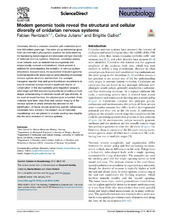Modern genomic tools reveal the structural and cellular diversity of cnidarian nervous systems
Peer reviewed, Journal article
Published version

Åpne
Permanent lenke
https://hdl.handle.net/1956/23618Utgivelsesdato
2019Metadata
Vis full innførselSamlinger
Originalversjon
https://doi.org/10.1016/j.conb.2018.12.004Sammendrag
Cnidarians shared a common ancestor with bilaterians more than 600 million years ago. This sister group relationship gives them an informative phylogenetic position for understanding the fascinating morphological and molecular cell type diversity of bilaterian nervous systems. Moreover, cnidarians display novel features such as endodermal neurogenesis and independently evolved centralizations, which provide a platform for understanding the evolution of nervous system innovations. In recent years, the application of modern genomic tools has significantly advanced our understanding of cnidarian nervous system structure and function. For example, transgenic reporter lines and gene knockdown experiments in several cnidarian species reveal a significant degree of conservation in the neurogenesis gene regulatory program, while single cell RNA sequencing projects are providing a much deeper understanding of cnidarian neural cell type diversity. At the level of neural function, the physiological properties of ion channels have been described and calcium imaging of the nervous system in whole animals has allowed for the identification of neural circuits underlying specific behaviours. Cnidarians have arrived in the modern era of molecular neurobiology and are primed to provide exciting new insights into the early evolution of nervous systems.
